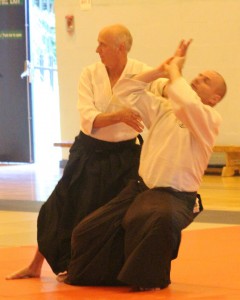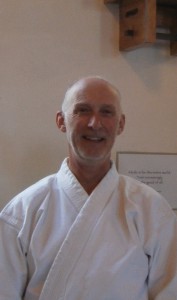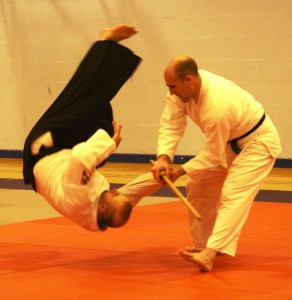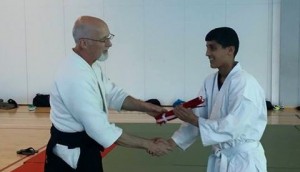Monkey See, Monkey Do by Mark Peckett
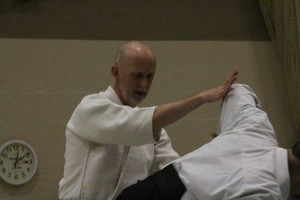 Something I heard years ago came to my mind recently and prompted me to do some research. It was a statement, probably by David Attenborough, that when monkeys were x-rayed, a surprising number of them turned out to have healed fractures.
Something I heard years ago came to my mind recently and prompted me to do some research. It was a statement, probably by David Attenborough, that when monkeys were x-rayed, a surprising number of them turned out to have healed fractures.
A trawl through the internet lead me to Episode 8 of “Life of Mammals”, indeed narrated by David Attenborough and called “Life in the Trees.”
It turned out he was talking about gibbons which swing from branch to branch for distances of up to 50 feet at speeds of up to34 mph so when a branch breaks or a hand slips researchers estimate that the majority of gibbons suffer bone fractures one or more times during their life!
This means that those monkeys we see swinging so beautifully through the trees on nature documentaries actually also manage to swing not so beautifully, missing the branch they’re aiming for and take a hard landing.
This is bad news for the gibbons, but good news for us because it means that gibbons do not have an innate ability to be the beautiful, agile creatures we see swinging through the trees – it is a skill they have to learn.
It also means that just like us, they can be plain unlucky. Sometimes a branch just breaks.
So we have a lot more in common with gibbons than some shared DNA. We have to learn our skills and we need our fair share of luck.
Think of the first time you learnt tai sabaki (or irimi tenkan). You probably got the first step and turn right, but when the whole class went back the other way, you probably carried on going forwards, or spun round on the spot, or ended up facing the wrong way or with the wrong leg forward, or a combination of all the above. That was certainly my experience – and sometimes still is if I don’t pay attention.
George Leonard, aikido 5th dan and president of the Esalen Institute, explains in better in his book, “Mastery”:
You feel terribly clumsy and disjointed. You have to think (author’s italics) to keep the parts of your body synchronised and thinking gets in the way of graceful, spontaneous movement.
In “The Aikido Student Handbook”, Greg O’Connor is a little kinder, acknowledging that it’s not just ourselves that get in the way, but the rest of the world doesn’t help either. He gives the following answer to the comment “I’m afraid I’ll be too clumsy and get embarrassed” in the chapter called “Common Questions”:
… we all experience clumsiness whether we are on the mat or not (it happens all the time). Teacups spill on occasion and feet so trip on all sorts of mysterious objects … if you think this doesn’t happen to everyone – think again.
Failing is part of the human (and gibbon) condition. As the American novelist O. Henry wrote:
Life is made up of sobs, sniffles and smiles, with sniffles predominating.
I think this is a fairly accurate description of much of everyday life for most of us. Occasional extremes of happiness (smiles) or sadness (sobs), but mostly it is the commonplace irritations that cause us to sniffle – driving to work, shopping, relationships and so on.
I don’t think however that gibbons look at it that way. Obviously they can’t be happy that they’ve fractured a bone; it would be a real ‘sob’ for them, but they can’t afford to dwell on it or they will die. They have to work out – and quickly – ways to deal with the injury until they recover.
But in an aikido class we tend not to think this way. When something goes wrong with our technique, a tiny fracture turns into a major break. Of course I’m not talking about actual bones here; thankfully in aikido we don’t get too many of those – painful joints maybe and stretched ligaments, muscle pulls and bruises – but not too many broken bones, because aikido emphasises the need to care for uke. People who want to hurt others tend not to stay very long.
No, I’m talking about the psychological fractures we are all familiar with, and seem to encounter on a regular basis in aikido. We struggle with a technique and feel like we might as well give up, we think we’re spoiling everyone else’s practice because we can’t get it right, we get embarrassed because we think we look so bad. The list goes on. And as a teacher, I can walk out of the class thinking “That was a terrible lesson. I wouldn’t be surprised if no one came next week. I bet they’re all talking about me in the changing rooms.”
But of course, none of that is true. To use some terms from Cognitive Behavioural Therapy we tend to:
- Catastrophise – taking relatively minor negative events and imagining all sorts of disasters from that one event.
- Engage in “All-or-Nothing” Thinking – where we are completely right or completely wrong.
- Start “Fortune-Telling” – because it was bad this week, it’s sure to be just as bad (or worse) next week.
- Mind-Read – thinking you know what other people are thinking.
- Over-generalise – “if it’s this bad now, it will always be like this.”
- Reason Emotionally – rather than relying on hard evidence. Actually if you look back, you are getting better at aikido. My students do come back next week.
- Label – good/bad, success/failure when in fact we are all of those things and everything in between.
- Make demands – “I must get better at this technique”, “I need to pass this grading”. You want to get better at the technique, and you will; you want to pass your grading, but even if you don’t, there’s always next time. It’s not a catastrophe (see above).
- Disqualify the Positive – you might not be very good this week, but if you look back, you’ve come a long way.
- Filter Mentally – the opposite of rose-coloured spectacles. Because you think you’re doing badly you don’t notice the good techniques you’ve done in the lesson.
- Develop Low Frustration Tolerance – we forget how we pushed ourselves to walk in the dojo in the first place, how we took that first grading or that first high breakfall. We are stronger than we think.
- Personalise – briefly, it’s not all about you (or me)!
So let’s not make the mistake of the King of the Swingers, the Jungle VIP, and consider ourselves a failure if we don’t have the secret of Man’s red fire – let’s rejoice in the fact that despite all the failures, we’re still up there swinging!



